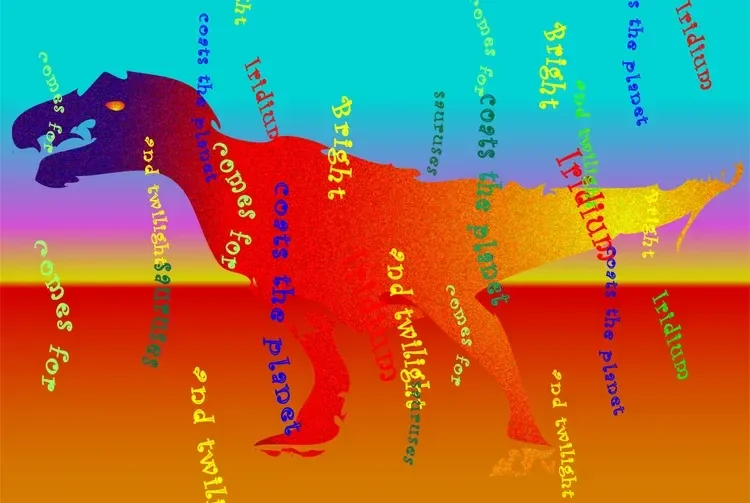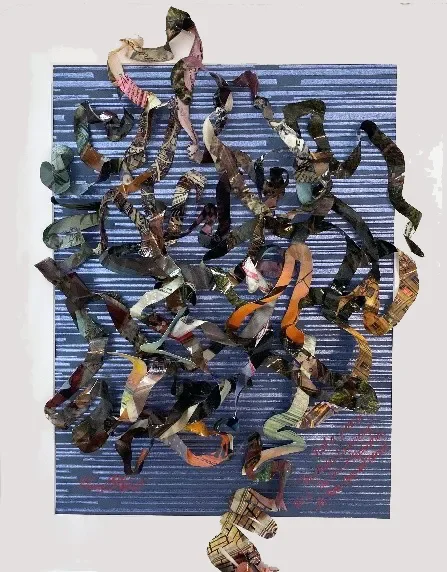“Past Masters
Spurlock and Tarrat oil history’s hinges. Also: Corson sculptures, Lee-McCann calligraphy, Ashton Reeder photography, Steven Ferri video, and more DMV Women
OCT 13, 2025
Langley Spurlock & John Martin Tarrat, “Yucatán” (Studio Gallery)
THE HISTORY OF THE WORLD as told by “S*** Happens” runs approximately from 66 million years ago, when an asteroid hit the Yucatán Peninsula and ended the era of dinosaurs, to 1945, when a U.S. A-bomb devastated Nagasaki. But the creators of this Studio Gallery show, artist Langley Spurlock and wordsmith John Martin Tarrat, don’t recount only cataclysms. Attention is also paid to breakthroughs in art and communication: the 15th-century invention of Hangul, the Korean alphabet; the 16th-century synthesis of red dye from cochineal insects in Mexico and the pigment’s exportation by the Spanish invaders; and the 1971 arrival of blue acrylic paint in the Australian outback, where it was integrated into the previously earth-toned paintings of Aboriginal artists.
European colonization is crucial to the histories of Mexico and Australia, and “S*** Happens,” which was curated by William Carroll, also memorializes other interplay between new and old worlds. In 1804, enslaved Haitians defeat imperial France to make their nation “the first Black republic.” A decade later, the brand new United States confronts the Barbary pirates. There’s also a less direct link to Europe’s subjugation of just about everywhere else: the bloodline of Russian writer Alexander Pushkin, whose great-grandfather was a kidnapped African servant given in chattel slavery to Peter the Great.
The breadth of Spurlock and Tarrat’s research is impressive, but what really distinguishes the D.C.-area collaborators’s projects is the cleverness of the presentation. Pushkin, for example, is visualized as a stop on a rail system whose other stations are each named for one of the author’s writings. Tarrat’s text is deftly integrated into the artworks, most of which are computer-generated prints on aluminum panels. (The notable exception is the stark “Nagasaki,” a ravaged wooden spike slammed off-kilter into shards of broken glass, some of which are engraved with such words as “plutonium” and “second sun burns even shadows.”)
Indian or Arabic script float through “Goa” and “Barbary Coast,” respectively, and English words spin toward the bottom of “North Sea,” as if caught in a whirlpool. In “Yucatán,” words and phrases take the place of cosmic debris, crashing to earth past a clueless dinosaur. At what the artists call “hinges” of history, contemporary observers rarely have a clue what’s going on.
AT THE CENTER OF CHRISTOPHER CORSON’S “MY CUP RUNNETH OVER,” also at Studio, is a ceramic sculpture of a kneeling man who’s holding a small bowl. The figure in “The Bowl” is painted gold, which in Buddhism signifies enlightenment. Does the gilded, physically intact figure represent a breakthrough for the local artist? Maybe not, but the 2025 sculpture is a significant contrast to the show’s earlier ones, which were made over the last 15 years.
This retrospective, which was curated by Mary Welch Higgins, consists mostly of sculptures in Corson’s usual mode. The nude figures, often unmistakably male, are typically pit-fired to give them partly charred patinas that are striking and slightly eerie. The blackened bodies are usually partial, often headless, and sometimes heart-less as well. The subject of “Chapel” holds open his chest to reveal a void, and the man in “As Was Done to Her” has a torn-open chest and a crow-like bird, perched on one shoulder, who reaches into the neck cavity to gnaw on an internal organ. He suggests Prometheus, punished for giving fire to humans by having an eagle feast daily on his regenerating liver.
The mythic struggles Corson symbolizes are more likely psychological than physical, and some cases are clearly political. The shackled hand of “Be the Voice” evokes the struggle for liberty and free speech. Overcoming is arduous, but perhaps possible. According to his statement, Corson has traveled a “path from difficult places to joy and gratitude.” Perhaps that’s why “The Bowl” has an unexpected luster.
INSPIRED BY A 500-YEAR-OLD CHINESE POEM that she writes is about “renewal and hope,” Freda Lee-McCann undertook a series of purely calligraphic pictures. These became her latest Studio Gallery exhibition, which was also curated by Carroll. The show is titled “Without Words,” which may seem odd for an array of what appear to be Chinese characters. But the painter traveled farther into illegibility than most artistic East Asian calligraphers, whose output can verge on unreadable. The characters she wrote “no longer have meaning,” she recently told a gallery visitor.
Lee-McCann has made purely calligraphic works before, but she’s known mostly for variations on classical shan-shui (”mountain-water”) ink paintings. There’s not a hint of that tradition in these elegant works, although sometimes the gestures are so tightly clustered that their totality suggests forests. Also adding to a sense of depth is the way the artist layers gray and black brushstrokes. (Two of the pictures also incorporate pink and brown.) The lighter strokes sometimes look like shadows of the darker ones, or appear to indicate that the brushwork is fading into oblivion. This sense of ephemerality adds to the pictures’s vibrant spontaneity. Lee-McCann’s wordless gestures can be read as flickers of mortality.
Ashton Reeder, from “Surveilling the Surveillers - Tech” (Photoworks)
THE INTERNET BEGAN AS A ROUTE FOR IDEAS, but it’s increasingly become a conduit for stuff. And as the worldwide web was commercialized, the existing computer networks that were originally sufficient had to be supplemented by lots of new gear, and ultimately whole neighborhoods of data farms. Many of the last are in northern Virginia, which is one of three areas scrutinized by Ashton Reeder’s “Planetary Computation.” The show is at Photoworks, where the D.C.-based photographer-technologist is artist-in-residence.
In addition to data centers in Ashburn, Dulles, Sterling, and Manassas, Reeder documents Silicon Valley as well as areas of Nevada that are being excavated for minerals used in high-tech devices. The photographer is particularly interested in AI, both as a technology and as a cause of frenzied speculative expansion of Internet capacity. Among Reeder’s subjects are homes owned by AI moguls Mark Zuckerberg, Peter Thiel, and Sam Altman.
Reeder didn’t just point a camera at mansions and industrial buildings. The show includes straightforward photos of Nevada mining sites and AI-touting billboards along California’s 101 highway, but most of the other pictures are pixelated or collaged. The artist photographed data centers with a low-resolution thermal camera that registers the hottest areas -- up to 130 degrees -- as white rectangles. He also produced layered “image net hallucinations” from leaked AI training data. The simple photos of Nevada mining towns offer a striking contrast to the AI-generated images. “Planetary Computation” travels from a brick-and-mortar world to a universe that threatens to become entirely chimerical.
Steven Ferri, “100% Pure Peace” (Transformer)
THE VIDEO IN TRANSFORMER’S WINDOW involves only three concrete ingredients: a toy soldier, a Mason jar, and some honey. But Steven Ferri’s brief art flick, which loops 24 hours a day, also features an intangible element: light.
That illumination might be termed “honeyed,” since Amish honey is the catalyst for the symbolic scenario of the local artist’s “100% Pure Peace.” The thick amber liquid is poured into the vessel that contains the silhouetted plastic figure until the fluid overflows and pools on the adjacent white surface. Then the action reverses so that the honey ascends from the jar until it entirely vanishes. In between the flowing and the unflowing is a moment when the soldier is hit by what appears to be a strobe light, whose intense flashes makes the toy appear to be yellow and then red.
Light also turns the honey red, so the video recalls Andres Serrano’s “Immersion (Piss Christ),” another luminous photographic rendering of a small object submerged in yellow liquid. That’s probably unintentional, and it’s possible that Ferri’s concern is the metaphorical overwhelming of war by sweetness. But surely he’s aware that his photography transformed the bit of pure honey into a sea of sumptuous complexity.
Becky McFall, “Volume 3: The Lure of Exploration - All Those Ones and Zeroes” (Zenith Gallery)
MOST SHOWS IN THE 18-VENUE “WOMEN ARTISTS OF THE DMV” project offer a single piece by multiple artists working in various media. Two exceptions to this approach are exhibitions at Zenith Gallery and the Portico Room of University of Maryland’s McKeldin Library. The first contains several works each by seven artists chosen by Zenith proprietor Margery Goldberg and the series’s overall organizer, Florencio Lennox (Lenny) Campello. The second consists of artists’s books, one each by six contributors.
Collages and wall sculptures dominate the Zenith show, although it does include Tracy Griffith Tso’s functional yet whimsical ceramics -- cups, flasks, and a teapot embellished with 3D rabbits and pandas. Two of the artists have shown recently at Zenith: Mitzi Bernard, whose pictures of women are assembled from hundreds of tiny female figures, often nude pinups; and Ashley Joi, whose collage-paintings often conjure women from snips of flowers and plants. One of Mentwab Easwaran’s sculptural paintings portrays a woman who’s part tree, but her work more often turns on colorful fabric patterns, presumably of Ethiopian origin.
The other artists also piece their works together. Jennifer Wagner’s glass mosaics build trees, waves, and a cat from simmering shards, while Margaret Polcawich combines abstract forms, made of wood and polymer clay, in shades of blue, green, and copper. Most energetic are Becky McFall’s abstract sculpture-paintings, most of which are topped with coiled strips of paper tinted with metallic inks. These ribbons pieces weave together sympathetically even as they project assertively from the surface.
Among the books at the McKeldin Library is Kanika Sircar’s multi-layered “Barthes,” made of paper on ceramic plates and recently shown at Washington Printmakers Gallery. Other highlights are Elizabeth Curren’s “The Paradise Fire,” a pop-up book with several layers of trees in flaming colors, and Kerry McAleer-Keeler’s “Skeleton in the Closet,” a boxed history of Prohibition written in corks, bottle caps, vintage prescriptions for whiskey, and other pertinent objects. Tina Huduk’s fold-out beach book, which contains short poems and small abstract pictures that suggest nature, is placed amid scattered sand and shells, as if the book had somehow summoned the environment that inspired it. Even the gentlest musings can be too vivid to stay on the page.
Langley Spurlock with John Martin Tarrat: S*** Happens
Christopher Corson: My Cup Runneth Over
Freda Lee-McCann: Without Words
Through Oct. 25 at Studio Gallery, 2108 R St. NW. studiogallerydc.com. 202-232-8734.
Ashton Reeder: Planetary Computation
Through Oct. 19 at Photoworks, Glen Echo Park, 7300 MacArthur Blvd, Glen Echo. glenechophotoworks.org. 301-634-2274.
Steven Ferri: 100% Pure Peace
Through Oct. 20 at Transformer, 1404 P St. NW. transformerdc.org. 202-483-1102.
Women Artists of the DMV
Through Oct. 18 at Zenith Gallery, 1429 Iris St. NW. zenithgallery.com. 202- 783-2963 and Oct. 23 at Portico Room, McKeldin Library, University of Maryland, 7649 Library Lane, College Park. 301-405-0800.”
Written by Mark Jenkins in DisCerning Eye, thank you!



